|
|
|
Sort Order |
|
|
|
Items / Page
|
|
|
|
|
|
|
| Srl | Item |
| 1 |
ID:
169919
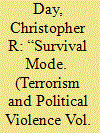

|
|
|
|
|
| Summary/Abstract |
To date, scholarly work on armed groups has seldom considered the notion of rebel resilience, or the factors that enable these groups to survive despite time, military pressure, and the myriad contingent events of civil war. In an effort to develop an explanatory framework for resilience as a distinct outcome of civil war and rebellion, this article examines the conditions under which the Lord’s Resistance Army (LRA) has persisted for nearly three decades. Based on fieldwork and original research, the article explains the LRA’s resilience in light of the group’s organizational structure and resource self-sufficiency, which have been well suited for the borderlands of East and Central Africa. The LRA is a key case of rebel resilience. It is important because it sheds light on the organizational foundations of armed groups, the relationship between resources and rebellion, and the broader study of conflict duration and termination. Understanding the sources of the LRA’s resilience can inform efforts to end such insurgencies.
|
|
|
|
|
|
|
|
|
|
|
|
|
|
|
|
| 2 |
ID:
124143
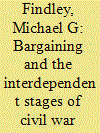

|
|
|
|
|
| Publication |
2013.
|
| Summary/Abstract |
This article examines civil war resolution as a process comprised of multiple interdependent stages. It engages directly the idea that peace emerges only as a process comprised of battle, negotiation, agreement, and implementation of an agreement. I hypothesize that events at earlier stages of the peace process have implications for later stages, but not always in the same ways. Drawing on bargaining models of war, I consider how two factors that might prevent successful bargaining-stalemates and the number of actors-can encourage cooperation early in a peace process but impede lasting cooperation at later stages. Using a nested dichotomies statistical approach to capture interdependence, I find support for the argument that stalemates and the number of actors have different effects depending on the stage of the peace process. The results substantiate the need in theoretical and policy work to consider peace as an interdependent, sequential process.
|
|
|
|
|
|
|
|
|
|
|
|
|
|
|
|
| 3 |
ID:
057922
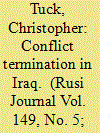

|
|
|
| 4 |
ID:
019680
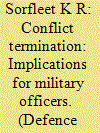

|
|
|
|
|
| Publication |
Spring 2001.
|
| Description |
49-74
|
|
|
|
|
|
|
|
|
|
|
|
|
|
|
|
| 5 |
ID:
184197
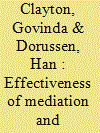

|
|
|
|
|
| Summary/Abstract |
Mediation and peacekeeping are commonly used tools to manage conflict. To what extent are they complementary and effective instruments for ending violent conflicts? Generally, they are seen as distinct tools: mediation aims to facilitate negotiated settlements, while the goal of peacekeeping is to prevent agreements from collapsing. However, peacekeeping and mediation regularly occur simultaneously. Arguably, peacekeeping operations rely on continuing political processes, while peacekeepers create a context favorable for mediation and provide a valuable source of independent information. Using a variety of model specifications, including selection models, empirical evidence supports that (a) mediation rather than peacekeeping is key to halting hostilities, (b) mediation and peacekeeping are largely complementary, but (c) this complementarity is conditional: in the post-Cold War period, transformative peacekeeping boosted the effectiveness of mediation to halt civil wars. There is no evidence that peacekeeping on its own matters for ending conflict. Finally, counterfactual analysis shows the substantial impact of mediation and peacekeeping on the frequency of conflict.
|
|
|
|
|
|
|
|
|
|
|
|
|
|
|
|
| 6 |
ID:
175333
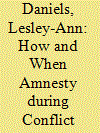

|
|
|
|
|
| Summary/Abstract |
n the difficult process of ending civil wars, granting amnesty during conflict is seen as a useful option, with an underpinning assumption that trading justice for peace is effective. However, is the case? This article tries to bring some clarity to when and how amnesty given during conflict has an impact. Amnesty should have different effects on diverse conflict endings: negotiated settlement, rebel victory, government victory, or conflict reduction. The article also disaggregates amnesties to test direct impacts as an incentive or through reducing the commitment problem, and indirect effects that give military advantage to the government. Using a cross-national data set of amnesties in dyadic conflicts from 1975 to 2011, the research finds that amnesty’s strongest effect is, surprisingly, not as an incentive but rather to reduce commitment problems. It can lead to negotiated settlements but also to government military advantage. The results have implications for negotiations and conflict resolution.
|
|
|
|
|
|
|
|
|
|
|
|
|
|
|
|
| 7 |
ID:
178735
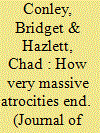

|
|
|
|
|
| Summary/Abstract |
Understanding how the most severe mass atrocities have historically come to an end may aid in designing policy interventions to more rapidly terminate future episodes. To facilitate research in this area, we construct a new dataset covering all 43 very large mass atrocities perpetrated by governments or non-state actors since 1945 with at least 50,000 civilian fatalities. This article introduces and summarizes these data, including an inductively generated typology of three major ending types: those in which (i) violence is carried out to its intended conclusion (37%); (ii) the perpetrator is driven out of power militarily (26%); or (iii) the perpetrator shifts to a different strategy no longer involving mass atrocities against civilians (37%). We find that international actors play a range of important roles in endings, often involving encouragement and support for policy changes that reduce mass killings. Endings could be attributed principally to armed foreign interventions in only four cases, three of which involved regime change. Within the cases we study, no ending was attributable to a neutral peacekeeping mission.
|
|
|
|
|
|
|
|
|
|
|
|
|
|
|
|
| 8 |
ID:
188087
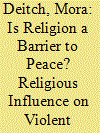

|
|
|
|
|
| Summary/Abstract |
In recent years, a burgeoning literature has emerged on the relationship between religion and conflict. Contradictory theories address the dynamics and termination of religious violent conflicts. Some studies focus on the destructive role of religion, arguing that religious conflicts are longer, more violent, and intractable. Others argue that religion has an ambivalent role, both destructive and constructive, and recognize religion as a force for peacebuilding. This study focuses on the relationship between religion and conflict termination by examining termination outcomes, based on the length and the level of violence, as well as incidents of reoccurrence. The study quantitatively examines 118 domestic conflicts between 1990 and 2014, utilizing the Political Instability Task Force and Religion and State datasets. The findings suggest that religious conflicts are likely to last longer than non-religious ones. However, the study reveals that religion has no strong significant influence on conflict termination as well as on the reoccurrence of conflicts and the violence level.
|
|
|
|
|
|
|
|
|
|
|
|
|
|
|
|
| 9 |
ID:
091000


|
|
|
|
|
| Publication |
2009.
|
| Summary/Abstract |
Theories of conflict emphasize dyadic interaction, yet existing empirical studies of civil war focus largely on state attributes and pay little attention to nonstate antagonists. We recast civil war in a dyadic perspective, and consider how nonstate actor attributes and their relationship to the state influence conflict dynamics. We argue that strong rebels, who pose a military challenge to the government, are likely to lead to short wars and concessions. Conflicts where rebels seem weak can become prolonged if rebels can operate in the periphery so as to defy a government victory yet are not strong enough to extract concessions. Conflicts should be shorter when potential insurgents can rely on alternative political means to violence. We examine these hypotheses in a dyadic analysis of civil war duration and outcomes, using new data on nonstate actors and conflict attributes, finding support for many of our conjectures.
|
|
|
|
|
|
|
|
|
|
|
|
|
|
|
|
| 10 |
ID:
169002
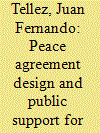

|
|
|
|
|
| Summary/Abstract |
Conflict negotiations are often met with backlash in the public sphere. A substantial literature has explored why civilians support or oppose peace agreements in general. Yet, the terms underlying peace agreements are often absent in this literature, even though (a) settlement negotiators must craft agreement provisions covering a host of issues that are complex, multidimensional, and vary across conflicts, and (b) civilian support is likely to vary depending on what peace agreements look like. As a result, we know much less about how settlement design molds overall public response, which settlement provisions are more or less controversial, or what citizens prioritize in conflict termination. In this article, I identify four key types of peace agreement provisions and derive expectations for how they might shape civilian attitudes toward conflict termination. Using novel conjoint experiments fielded during the Colombian peace process, I find evidence that citizens evaluate agreements based primarily on how provisions mete out justice to out-group combatants, and further that transitional justice provisions produced sharp divisions among urban voters in the 2016 referendum. Additional analysis suggests that material, distributive concerns were particularly salient for rural citizens. The results have implications for understanding the challenge of generating public buy-in for conflict termination and sheds light on the polarizing Colombian peace process.
|
|
|
|
|
|
|
|
|
|
|
|
|
|
|
|
| 11 |
ID:
124112
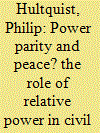

|
|
|
|
|
| Publication |
2013.
|
| Summary/Abstract |
Theories of civil war highlight how relative power affects conflict onset, dynamics, strategy, outcome, and duration. Yet most studies of civil war have not been able to capture rebel power adequately and often rely on national-level characteristics to infer relative power distributions. This study addresses this shortcoming by using a troop strength measure to test arguments about how relative power affects the likelihood of civil conflict settlement. Drawing on the international crisis bargaining literature, while noting the inherent differences between interstate and intrastate conflicts, this study argues that the condition of power parity increases the likelihood of negotiated settlement and ceasefire. Weak rebels are unable to achieve concessions through negotiation since governments view them as minor threats. Yet governments have difficulty defeating weak rebels due to an emphasis on guerrilla warfare. On the other end of the spectrum, rebels that are superior to the government in strength are unlikely to settle given their power advantage. Strong rebels that can rival the strength of the government (i.e. they are near parity) can exact more concessions because fighting at parity exposes information about how long each side can hold out while escalating the costs of war, giving each side a greater incentive to negotiate and eventually seek a ceasefire or peace agreement. This argument is supported using data on 112 dyads in the post-Cold War period.
|
|
|
|
|
|
|
|
|
|
|
|
|
|
|
|
| 12 |
ID:
117017
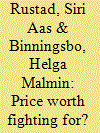

|
|
|
|
|
| Publication |
2012.
|
| Summary/Abstract |
While a number of publications show that natural resources are associated with internal armed conflict, surprisingly little research looks at how natural resources affect post-conflict peace. This article therefore investigates the relationship between natural resources and post-conflict peace by analyzing new data on natural resource conflicts. We argue that the effect of natural resources on peace depends on how a country's natural resources can constitute a motive or opportunity for armed conflict. In particular, three mechanisms may link natural resources to conflict recurrence: disagreements over natural resource distribution may motivate rebellion; using natural resources as a funding source creates an opportunity for conflict; and natural resources may aggravate existing conflict, acting either as motivation or opportunity for rebellion, but through other mechanisms than distributional claims or funding. Our data code all internal armed conflicts between 1946 and 2006 according to the presence of these resource-conflict links. We claim such mechanisms increase the risk of conflict recurrence because access to natural resources is an especially valuable prize worth fighting for. We test our hypotheses using a piecewise exponential survival model and find that, bivariately, armed conflicts with any of these resource-conflict mechanisms are more likely to resume than non-resource conflicts. A multivariate analysis distinguishing between the three mechanisms reveals that this relationship is significant only for conflicts motivated by natural resource distribution issues. These findings are important for researchers and policymakers interested in overcoming the 'curse' associated with natural resources and suggest that the way forward lies in natural resource management policies carefully designed to address the specific resource-conflict links.
|
|
|
|
|
|
|
|
|
|
|
|
|
|
|
|
| 13 |
ID:
125253
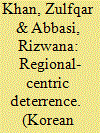

|
|
|
|
|
| Publication |
2013.
|
| Summary/Abstract |
It is generally believed that a stable nuclear deterrence averts wars between nuclear adversaries, and makes peace secure. This conceptual argument has merit in terms of the prevention of all-out war; but it does not fully address the need to prevent the outbreak of a limited war between two nuclear weapon states. India and Pakistan have already fought one limited war, Kargil, in a nuclear environment. These two relatively new nuclear weapon states rely on nuclear deterrence to address the external threats. While frequently occurring conflicts demonstrate this, a recurrence of limited war cannot be ruled out in this crisis-ridden region, which would be fraught with significant dangers of escalation. Using a qualitative research approach and deploying a structural deterrence theory as a conceptual guiding tool, this paper investigates the nuclear future of the region, including the prospects of war, conflict termination strategy, escalation control, escalation dominance mechanisms, and finally suggests some pertinent lessons for crisis stability.
|
|
|
|
|
|
|
|
|
|
|
|
|
|
|
|
| 14 |
ID:
168797
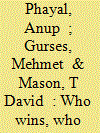

|
|
|
|
|
| Summary/Abstract |
Previous research has shown that the outcome of a civil war is related to conflict duration: military victory by either the government or the rebels occurs early if it occurs at all, and the longer a civil war lasts, the more likely it is to end in a negotiated settlement. The models of civil war duration and outcome that have produced these findings are built on characteristics of the civil war and less on attributes of the state itself, other than where the state lies on the Polity autocracy-democracy scale. We propose that how civil wars end varies not only between democracies and authoritarian regimes but among the different authoritarian regime types identified by Geddes, Wright, and Franz. The distinguishing attributes of these regime types—democracy, one-party, personalist, military, monarchical—should lead to different likelihood in defeating a rebel movement, being defeated by a rebel movement, and negotiating a peace agreement with a rebel movement. Results from a series of competing-risk models using the Uppsala–Peace Research Institute Oslo Armed Conflict Dataset demonstrate support for our claim that how civil wars end is partly a function of the characteristics of the regime.
|
|
|
|
|
|
|
|
|
|
|
|
|
|
|
|
|
|
|
|
|